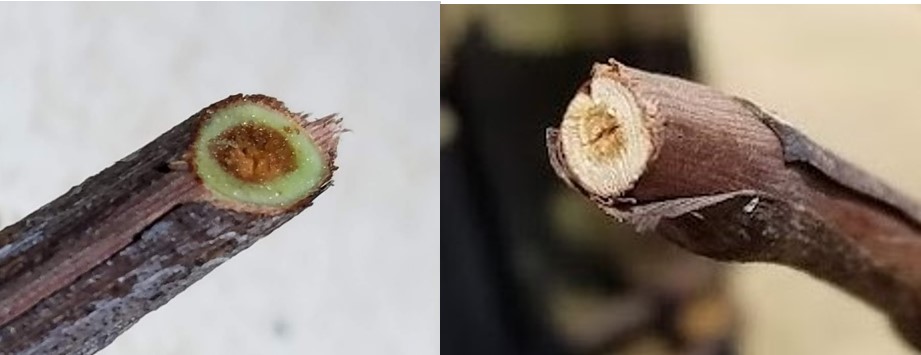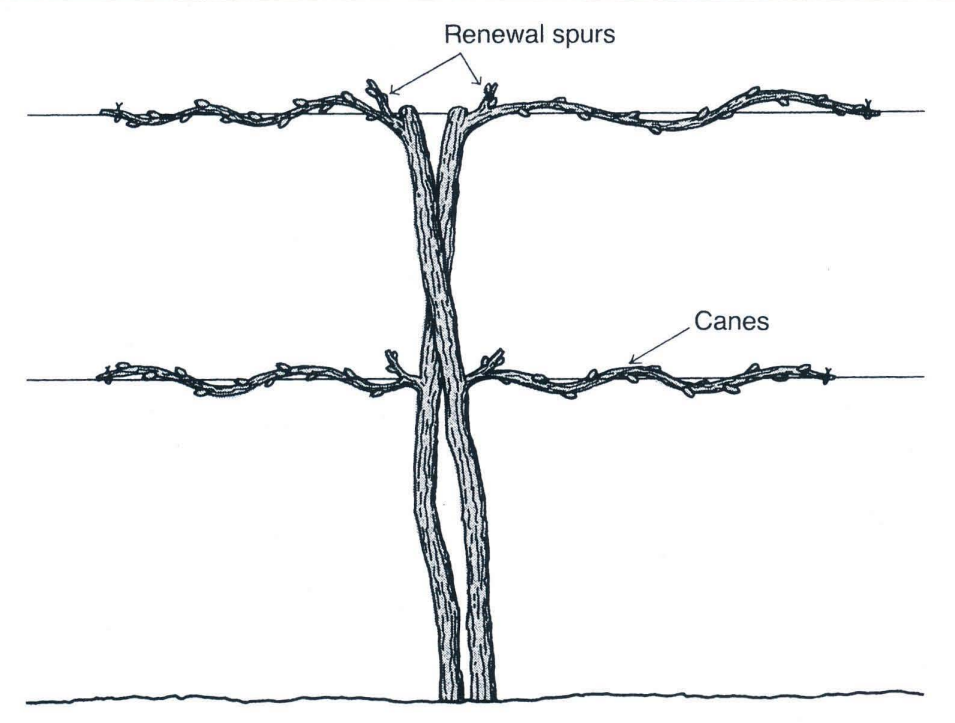Taming the monster: How to prune overgrown grapevines
Grapevines require annual pruning for health and productivity.

Grapes have long been esteemed for the beauty of their vines and the complex flavors of their fruit and wine (Photo 1). Although not difficult to grow, grapes do require some annual maintenance to ensure consistent harvests of high quality fruit. Neglected vines can quickly outgrow their space and supports, leaving home gardeners struggling with how to proceed. Here are the steps to take to tame overgrown grapevines, restoring health and productivity through proper pruning.
Why prune?
Annual pruning is important for the health and productivity of grapevines. Left unpruned, grapevines may have high yields of fruit, but the grapes will be smaller and of lower quality. After several years, an irregular pattern may set in for some grape varieties, with large crops one year followed by small crops the next. This alternate bearing results from the stress and demands of carrying large crop loads, and both vigor and fruit quality may be reduced.
When to prune?
Although grapes may be pruned any time during winter dormancy, it is best to wait until the risk of spring freezes has passed. Pruned vines break dormancy earlier, making them susceptible to freeze injury. If it has been a very cold winter and heavy winter damage to the vines and buds is likely, grapevines may be pruned after bud break, making it easy to select from canes that are producing healthy, new shoots. Although the vines will bleed sap after pruning, this sap loss is not harmful to the plant.
Determining winter damage
It is a good idea to check the canes and buds for winter damage before pruning. Damaged canes often appear darker and look less healthy. The buds, located at each swollen node, may be mushy or shriveled. When a healthy bud is sliced open, it will appear green inside, while dead or injured buds will be brown, black or very dull green. Cut open a few healthy buds from canes that will be pruned off and compare those to the buds you think might have been injured by the cold. The difference should be readily apparent. The health of a cane may be determined by pruning the cane and examining the cross section of the cane at the pruning cut. The cross-section of a healthy cane will have a green circle of living tissue. If it is brown and dry, the cane is dead (Photo 2).

Training systems
When grapevines are young, they are guided—or trained—into any number of desired shapes, sometimes emphasizing aesthetics, such as covering an arbor, but most often to promote efficient fruit production. There are many different methods, termed training systems, that may be used to establish the structure of a grapevine when it is young. The reason so many systems exist is because grape varieties differ widely in growth habit and vigor, and therefore respond very differently to training. The trellising used to support the vines can offer clues to help determine which training system was originally used to establish the vine. The most common method uses posts sunk into the ground with at least two wires strung between them, running parallel to the ground at heights of around 2.5 feet and 5 feet above the ground. If there are additional wires on supports branching out from the posts, a more complicated system has been used. In that case, refer to Growing Table Grapes for more information on training and pruning.
Training and pruning
Assuming the grapevine is supported by two parallel wires strung between posts, the simplest way to train grapes is using the four-arm Kniffin system (Photo 3). This system works best for Concord-type or lubrusca-type grapes and provides good air and light infiltration during the hot summer months. With this system, a perennial trunk—identifiable by its shaggy bark—is trained up to the top wire. In badly neglected vines, there may be many old, thick arms growing sideways along the wires. You want to keep the vertical trunk, but prune away the older arms, which lack the vigor of younger canes.

But before cutting anything, the first step is to decide what canes should be kept. Select two canes originating from the trunk near the top wire to position along the top wire, one to the right and one to the left of the trunk. Mark these canes with flagging tape or twine. Do the same for the bottom wire. Select 1-year old canes of moderate vigor. One-year-old canes will be smooth and reddish-brown while older canes will be grayer with a more coarsely textured bark. Look for canes that are about 0.25 to 0.375 inches in diameter. Smaller canes will not be very vigorous or productive, and larger canes will grow too vigorously and not produce good fruit.
The next step is to select renewal spurs for the marked canes which have been selected to train along the wires. For each marked cane, choose a moderately vigorous, 1-year-old cane originating from the trunk near the marked cane. Prune this newly-selected cane, leaving just two buds. At least one of these buds will grow into a new cane which can be trained along the wire next year. Renewing the lateral arms each year will ensure good production of high-quality fruit for years to come.
There should now be a total of four marked canes and four renewal spurs. Being very careful to not damage the four marked canes, prune off all of the remaining canes. This pruning will remove close to 90% of the vine, but it is essential to keeping the grapevine healthy and productive. Once those canes have been removed, the final step is to carefully position the marked canes along the wires, two along the top wire to the right and left of the trunk, and two along the bottom wire in the same fashion. Tie each cane loosely to the wire. Be careful not to break the cane.
Once pruning is complete, the resulting vine will form a vertical trunk with lateral arms extending in each direction outward from the trunk along both horizontal wires, and a renewal spur near each lateral arm (Photo 3). Following these same steps every spring will maintain the health and productivity of the grapevine for years to come! For more information, check out these additional resources for growing grapes available from Michigan State University Extension.



 Print
Print Email
Email




